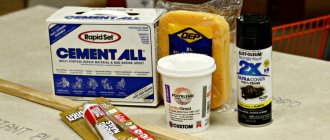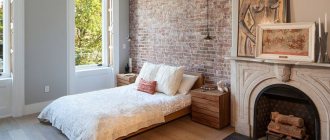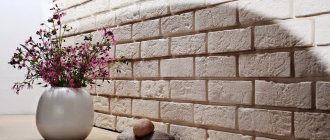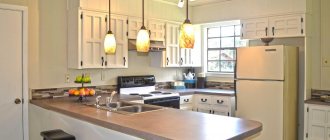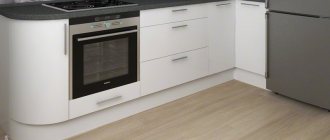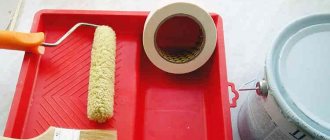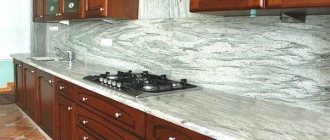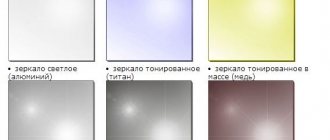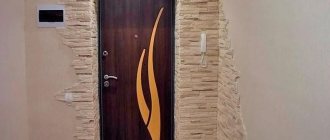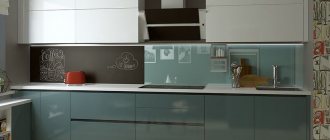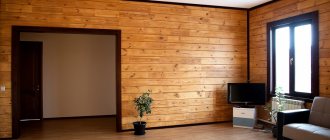Among facing materials, gypsum tiles, a decorative artificial stone, are becoming increasingly popular. The demand is explained by the high aesthetics and properties of the lightweight porous material. This material can be used to cover lightweight structures and temporary partitions.
Decorative stone is a trendy decoration for any room.
Advantages and disadvantages of gypsum cladding
Covering with artificial stone made of gypsum is superior to its analogues in many respects. The tiles are valued for their beauty, the ability to be installed independently, and their similarity to natural materials. Tiles can be purchased ready-made or made with your own hands using special matrices. These are reusable silicone, polyurethane or plastic molds.
Gypsum is a fire-resistant material on a natural basis. It is classified as an environmentally friendly raw material. Therefore, brick-like gypsum tiles are used for interior decoration of residential buildings.
You can install decorative stone in your apartment yourself.
Decorative stone made of gypsum has excellent decorative qualities, although it is produced from an affordable gypsum-cement mixture. Natural gypsum is much lighter than cement due to its porous base.
The soft natural material in powder form is pleasant to knead in your hands. It is warmer in contact than wild stone made from a cement mixture. As a ready-made tile finish, it is suitable for any interior space:
- bathroom and toilet;
- hallway and corridors;
- staircase space;
- kitchen and dining room;
- separate corners when zoning a studio apartment.
Decorative stone looks interesting in the bathroom.
Similar cladding is found in houses and apartments, hotels and banking institutions, shopping centers and public institutions. This decor is chosen by construction companies due to its advantages:
- The tiles have a low specific gravity, simplifying installation on thin partitions and lightweight architectural structures, where weight overload is unacceptable;
- Thin decorative plates with delightful relief are the best facing material for any surface. This finish can easily hide any unevenness or defects in the walls.
- The material is easy to cut, laid on cement mortar, grouting gives the effect of a continuous rocky surface.
- The raw material has an average frost resistance coefficient. Rocky stone is preferred for interior decoration of country houses where there is no heating in winter.
- The tile resists overheating, which is why it is used in finishing near stoves and fireplaces.
- The relative cheapness and low cost of homemade gypsum decor makes it accessible to the population.
- Due to environmental safety, it is allowed to decorate classrooms and preschool premises with gypsum stone.
Caring for white gypsum board is not difficult.
A wall with stonework looks great in the interior, while the new finish, over the years, becomes covered with dust and greasy residue. If you choose a suitable coating, then dirt on gypsum boards is less noticeable. The old coating can be easily renewed, removed or repainted.
Among the disadvantages is the fragility of the finished facing material. Strength can be easily enhanced with special additives and plasticizers. A brick wall is also susceptible to moisture.
The finished surface can be coated with a colorless water-repellent varnish. Gypsum panels should not be used for exterior decoration. Other cement-based materials are offered there.
Decorative gypsum brick for interior decoration
Currently, unplastered brick walls are not very common in apartments. If you want to decorate your interior in a fashionable loft style, you shouldn’t do real brickwork. This is quite difficult, tedious and will cost you a lot. It is better to pay attention to a practical decorative stone made of gypsum; it is ideal for interior decoration. This modern coating is very durable. It is also attractive from an aesthetic point of view - in appearance this imitation is very similar to a real brick wall.
Let's summarize why you should choose decorative gypsum stone for interior decoration of an apartment:
- This design of the home makes it original, it adds coziness to the atmosphere.
- Most often, door openings and arches in the room are lined with this material. The atmosphere in the house immediately changes when, instead of the usual wooden slopes, there is an interesting frame of the doors with gypsum material “like stone”.
- You can quite successfully disguise or decorate various protruding corners in the room.
- Decorative gypsum stone is the best solution for interior decoration of particularly vulnerable areas that are constantly dirty and subject to deformation, where wallpaper quickly deteriorates.
- This material will not only protect such areas, it will also decorate them, turning them into original decorative elements of the interior.
- You can decorate all kinds of niches and mirrors in this way, designers often do this - customers like it. It’s easy to choose the appropriate option using photos or videos.
- You can use decorative plaster not only for the interior decoration of the entire wall in the room, but also for some part of it. An original combination: a section of masonry with “torn” edges made of gypsum stone or gypsum tiles of a contrasting shade and texture are combined with decorative plaster or wallpaper.
- Gypsum material is extremely hygienic; it can be safely used to decorate a room for children. It is pleasant to the touch and easy to handle.
There are different types of decorative gypsum panels suitable for interior decoration. You can buy them at any hardware store. This material can look completely different. For example, there are such products:
- with a matte surface, a special impregnation is used to protect it;
- with a glossy finish, this is achieved using a finishing layer of varnish;
- with a convex or concave surface;
- relief tiles with an original three-dimensional pattern.
Before starting interior decoration, it is recommended to first lay out the structure on the floor or on drywall in order to select the appropriate laying pattern and color of the tiles.
For work you will need the following tools: a file, pliers, a tape measure, a sharp knife and side cutters for trimming and cutting off excess areas of the material.
When working, the following points must be taken into account:
- You need to do the cutting carefully, carefully removing small pieces so as not to break the tile.
- Before installation, the surface is cleaned, plastered and primed.
- Decorative panels made of gypsum are installed for interior decoration using any adhesive mixture, such as mounting adhesive, diluted putty or PVA.
- The adhesive composition is applied to the prepared base using a spatula.
- During interior finishing, gypsum stone is laid by pressing it to the surface so that excess glue can be squeezed out and fill all the voids. This will make the masonry stronger.
- You should not lay out more than one meter of coating in height at a time; the solution will not have time to dry.
- During installation, it is necessary to regularly check the masonry for its horizontal and vertical position. Minor irregularities are acceptable only in artistic style.
- At the end of the work, you need to fill all the seams, and you can cover your brickwork with varnish. This will emphasize the depth of color and make it easier to maintain in the future.
Decorative gypsum stone is appropriate for interior decoration of any premises; there are no restrictions for this. The only point is that a sense of proportion must be observed.
Decorative properties of gypsum tiles
There are several types of dry raw materials:
- natural, alabaster is made from it;
- medical plaster;
- especially durable (construction);
- artistic (sculptural);
- modified composition (with additives that change properties, depending on functional requirements).
Knowing the properties of gypsum tiles, you can easily choose the right care for them.
Dry building gypsum is most in demand. In the form of a solution, it is used to seal grooves under communications, masking shrinkage cracks and defects. This is the basis of mixtures for plaster and stucco. In its pure form it is less in demand - raw materials diluted with water quickly thicken, gross errors cannot be corrected after 10-15 minutes.
Decorative stone can easily hide unevenness and unsightly places in a room.
Ventilation ducts, protruding structural fragments and arched lintels can be easily hidden behind a stone design. The masonry looks good both in solid form and in “unfinished” form.
Important! It is not advisable to glue the cladding onto unstable substrates that change parameters due to temperature contrast or soaking (wood derivatives).
Niches and arches with unobtrusive stone or brick installation look great in an urban interior. An interesting technique is an accent wall with decorative gypsum tiles for a large display or plasma television panel, as in the photo.
Antique interiors are gaining popularity.
Application
Artificial stone or gypsum brick can be used to decorate the entire room, as well as one wall or a small section of it. This material is often used to create accents in the interior: it is used to decorate niches, fireplaces, and columns.
Brick-like tiles are popular for finishing loft-style interiors, as in the photo, because it is not always possible to build a real brick wall in an apartment. Its rough texture is well suited for this direction. Stone-effect tiles are used in various architectural styles.
Advice! Before laying the tiles, lay a sample of them and see how they look.
For stone-look tiles, the direction from which the light falls is very important. Side lighting will advantageously emphasize the relief, while frontal lighting is best avoided.
As with other finishing materials, light cladding visually expands the room, while dark cladding makes it smaller. In small rooms, such as small rooms, balconies, loggias, it is better to tile not the entire wall, but individual fragments. It is better to cover large areas in large rooms: living rooms, halls. Most often, individual elements are decorated with stone-like tiles: niches, fireplaces, stoves (in this case, its fire-resistant properties are very useful), ventilation ducts, stairs. You can see an example of finishing in the photo.
Types of gypsum tiles for interior decoration
Having special equipment, it is easy to recreate any surface of natural stone.
Today in specialized catalogs you can find any imitation of a rocky surface or brickwork.
The collections contain samples with imitation sandstone and shell rock, crushed and dolomite brick, and rocky stone.
There are a large number of varieties of gypsum tiles.
Under the stone
Artificial stone is a “hit” of design projects in modern style. “Wild” stone has varieties that have received commercial names. Rocky stone, laid without clearly defined seams with different reliefs, forms a kind of canvas with a pattern without a repeating rhythm. This gives the most naturalness.
Stone tiles are quite thin, so it is better to lay them with construction adhesive, then fill the joint. If desired, you can coat it with matte varnish for ease of maintenance. It is recommended to vacuum the wall.
Under the brick
Loft tiles designed to look like rough porous bricks are quite in demand in modern, modern or high-tech interiors. Often such decor becomes almost the only decoration of urban design.
Brick-like gypsum tiles are often used in loft-style rooms.
Helpful advice! When making your own gypsum tiles for interior decoration, you can add pigment to get a more “natural” material. Another option is to leave the mixture colorless for subsequent painting.
White “masonry” is perfectly perceived in any room:
- bedroom (wall at the head);
- living and dining room;
- kitchen (work wall);
- entrance hall with corridor.
Using gypsum, dyes, inclusions and matrix molds, it is also easy to recreate the surface of any brick. Clinker or refractory, silicate (white) or ceramic (red) - thin layers are lighter than the original material. Such an imitation will not put additional load on the building, unlike a real brick partition or pier.
Where are gypsum decorative tiles used?
It is clear that with its characteristics it is impossible to use tiles for outdoor use. It is intended for decorating interior rooms. Most often, tiles are used for country houses and apartments. It is used to decorate not only rooms, but also balconies and loggias.
But, in addition to this standard area of use, gypsum tiles can also be seen as decoration in office premises, restaurants, exhibition halls or hotels. If we compare gypsum finishing with ceramic, then the second one can even be used to finish small parts of the structure and it will look quite decent. For example, look at the photo to see how stone-look gypsum tile trim looks on a fireplace.
It can also be used to decorate columns and individual parts of the structure, such as arches or corners of the room. As for decorating a room in a certain style, such a move is ideal for creating a loft style.
As for the surface on which gypsum tiles can be laid, there is room for improvement. It can be mounted on concrete, brick, plasterboard or plaster walls. We'll talk more about how the finishing is done later. And if we make a small summary, we can draw a conclusion: gypsum decorative tiles are used for finishing any premises (except for warehouses and production facilities). It perfectly protects the wall and transforms the structure as a whole.
Composition of gypsum tiles
The lightweight, versatile finish was developed as an alternative to heavy natural stone. Decorative tiles to look like crushed stone are made on a gypsum base. The only difference is the thickness of the plates and the design of the structure. Experiments were carried out on proportions and additives until a plastic composition for filling molds was obtained.
Each tile manufacturer has its own secrets regarding the production of gypsum products for decoration.
Today, artificial stone is produced on different bases:
- quartz;
- acrylic;
- plaster.
The decorative material contains not only the main components, but also inclusions in the form of sand, modifiers, and surface-active components. To make gypsum mixture use:
- 6 parts plaster;
- 1 part slaked lime (a little less citric acid);
- 0.7 liters of water for each portion of dry plaster.
- pigment (proportions are indicated in the instructions).
You can make your own gypsum tiles for cladding interior walls.
On sale you can find a ready-made mixture for making tiles at home. Usually thickeners and plasticizers are added to it; they make the gypsum stronger, but the mixture does not harden so quickly. The proportions and amount of water may vary - it is important to follow the technology recommendations.
Features of gypsum tile products
Gypsum is one of the widely used building materials. Used mainly in interior design, as surface materials for walls, ceilings, stucco. Decorative parts are made from it:
- sockets for a chandelier;
- internal cornices;
- ceiling frames;
- decorative columns and much more.
Gypsum tiles always look beautiful in the interior
Gypsum is also used to imitate plaster. It is also produced as prefabricated block, such as drywall.
Gypsum is a white to gray mineral found in the earth's crust. Chemically it is known as calcium sulfate hydrate (CaSO4.2H2O), which is obtained by extraction from large veins. For interior decoration, a translucent gypsum stone called alabaster is usually used; it is suitable for any sculptural forms. In its natural state it consists of about 30% bound water. This water is extracted through continuous heating to obtain a white powder.
Has many design advantages
For the manufacture of gypsum tiles and other gypsum materials, it is this naturally occurring gypsum that is used as a raw material . So-called synthetic gypsum is made from it. This is done using wet limestone, which is a combination of calcium and water, combined with sulfate to form calcium sulfate.
How is plaster different from other surfaces?
Among its qualities there are unique ones, in particular the following:
- has no foreign odors, completely safe;
- widely available in nature;
- comfortable, aesthetic material;
- easy to install;
- fire resistance;
- durability;
- sound insulation;
- heat resistance.
This material is fire resistant and durable
Nowadays, most interior and exterior design features are mainly controlled by gypsum construction or gypsum molding.
The demand for this material is due to another factor: less time, cost of work. Over time, gypsum products acquire more and more advanced properties, such as increased fire resistance, acoustic properties for sound insulation, etc.
Gypsum tiles - easy to install
Properties
Fire resistance
It is naturally fire resistant, stopping the spread of fire, which can be critical to safety and life. This property is due to the presence of water, which is present in gypsum products. Let's say a 15 mm thick gypsum tile contains almost 3 liters of crystallized water. As the fire approaches the water, the water undergoes evaporation, resulting in a protective layer that covers the gypsum product. This property will help stop the spread of fire from other materials.
Good sound insulation
Non-flammable
As explained, heating gypsum products causes the water crystals present in the gypsum material to heat up.
This dehydration of gypsum by heat is called calcination. Firing results in a coating that prevents it from burning, allowing the material next to it to maintain a lower, safer temperature. Even after the water crystals are completely calcined, the residue will act as an insulating layer until it is destroyed. Gypsum is considered a good fire retardant due to its ability to stop the spread of fire for several hours depending on the amount of gypsum products.
Has no foreign odors
Acoustics
Gypsum products are famous for their soundproofing properties, which are much more effective than brickwork, if we take the same thickness.
Gypsum is specially formulated to reduce noise and prevent reverberation. The space between two plaster walls results in higher acoustic performance by limiting the passage of noise. For example, instead of a 110mm thick brick wall, we can install 75mm thick gypsum boards to achieve the same sound performance. Can be matched to any style
Heat resistance
The thermal properties created by the gypsum structure will ensure a good balance of humidity and temperature in the room. Gypsum construction incorporating cavities such as plasterboard or formwork provides additional insulating properties.
Vapor barrier
The use of gypsum boards in interior design prevents humidity in the room.
Can be used in any room
Gypsum tile sizes
Gypsum is the lightest base for simulating the texture of stone. Approximately weight 1 sq.m. decorative coating no more than 10 kg. Volumetric slabs imitating torn stone weigh slightly more than their ceramic counterparts, but differ in design and size.
Gypsum tiles come in many variations of shapes, sizes and colors.
Catalogs and construction supermarkets offer a wide range of tile-type coverings. Gypsum “stone” is produced in a standard format (dimensions are given in mm):
- length – 148, 200, 210, 240, 300 and 330;
- height – 65, 70, 85, 100, 200 and 300;
- thickness – 8, 10, 15, 22, 30, 40 and 45.
It makes no sense to produce thinner ones; the slabs will be fragile. Too thick - also no point, they weigh down the finish and complicate installation.
Each specialist knows how to independently choose the thickness and size of gypsum tiles, focusing on the properties of the wall and other factors.
Important! On an individual order, enterprises engaged in the production of this type of cladding can produce a non-standard format for stone or brick, subject to a large wholesale batch.
Color scheme and design
The decorative properties of gypsum tiles are beyond doubt.
It is suitable for finishing rooms in different styles:
- all types of urbanism, including loft, hi-tech or techno;
- oriental flavor (Moroccan and Turkish, Chinese and Japanese);
- eclectic varieties where design traditions from different eras and cultures are mixed;
- country, where “naked” brick or stonework is cultivated;
- minimalism.
The most popular is white gypsum tiles.
Common color variations:
- white color (base without adding color);
- milky or creamy;
- beige tone with all transitional shades;
- sand;
- all shades of chocolate and terracotta;
- gray-green and lilac-gray;
- pistachio;
- brown tones;
- whole palette of gray shades.
Visually, warm colors, beige with yellow, terracotta or chocolate are best perceived.
A “stone” wall or artificial brickwork is a hit with many interior styles. When choosing a shade, they are guided by the general design concept and the preferred range - in warm, cold or neutral tones.
Tips for choosing a tone
Before purchasing gypsum tiles for surface cladding, you should consider:
- A light tone enlarges the room, making it spacious and large.
Gypsum tiles in the interior of the hallway - A dark tone makes the room smaller, compresses, depriving it of comfort.
Options for shades of gypsum tiles for brick - Red, chocolate tone, coffee with milk adds energy to the room. Red is a bit extreme and can create a feeling of aggression when used in excess.
- Blue color will bring peace.
- The green tone will relieve depression and add a touch of joy.
- Gray tones fit into any interior. This is a classic color that brings stability.
- Yellow tones are mainly used in children's rooms; they symbolize sunshine and childhood.
- You can use a black tone for edging, nothing more.
These color schemes will help you decide on the choice of gypsum tiles for your apartment for surface finishing.
Gypsum tile finishing technology
The decor layers are easy to cut; use a regular hacksaw (small teeth). It is better to work with power tools with suitable attachments at medium speeds to avoid cracks.
The low weight of gypsum decor has the advantage of easy installation. You can take cement mortar or construction adhesive for gypsum plasterboard; any composition for tiles is allowed. A “solid” wall will look different with different grout.
Use modern techniques when laying gypsum tiles.
Important! If the adhesive contains gypsum or light cement, provided the installation is done carefully, you can do without grouting.
At the end of each row, it is recommended to clean up any installation flaws. For colored tiles, you will have to tint the adhesive with pigment to avoid the need for grouting. High-quality filling of joints in the same tone as the tiles will make the cladding more aesthetically pleasing. The fewer filled voids between the layers, the more convenient it will be to subsequently care for the masonry of torn stone, especially in the kitchen and bathroom.
Always strive for a perfect tile installation.
The process of installing gypsum tiles
Just like manufacturing, installation of the slabs is simple. You just need to take care of all the necessary tools and materials in advance. What are they? Here is the list:
- set of spatulas: serrated and simple;
- building level and pencil;
- grinder or hand saw;
- drill with mixer attachment;
- miter box;
- bones;
- construction gun;
- foam sponges;
- trowel;
- sandpaper;
- gypsum or ceiling glue. Even liquid nails are allowed;
- dye for seams;
- primer mixture;
- water-based varnish;
- grout for seams.
Stage 1 – marking for gypsum tiles
To simplify the task, the first step is to mark the wall. To begin with, the starting points, vertical and horizontal, are found. This is necessary to ensure that the finished finish is smooth and neat. Since laying the tiles begins from the corner, the markings are tied to it. When working, use a regular or laser level.
Stage 2 – laying gypsum tiles
It begins with preparing the adhesive composition. To do this, use a mixing attachment for a drill. The consistency of the glue should resemble sour cream. The surface on which the gypsum tiles will be applied is treated with a primer in advance in order to have time to dry before gluing. This is necessary for better adhesion to the surface.
Next, the adhesive composition is applied to the wall. Residues are removed with a notched spatula. It evens out the surface. All that remains is to attach the gypsum tile to the surface, pressing it tightly. As you can see in this photo, the adhesive can be applied to the tiles, and not to the base.
If we are talking about brick-type masonry, then seams must be formed. To maintain the distance between individual elements, available material with the same thickness is used. No seams are needed for stone cladding.
Stage 3 – cutting gypsum tiles
Since gypsum is quite soft, it is not necessary to cut it with a grinder. You can also use a hacksaw. External corners will need to be joined correctly. To prevent the overall appearance from deteriorating, individual elements are cut at an angle of 45 degrees. For this purpose you will need a miter box. And to bring the cut elements to perfection, sandpaper is used.
If you need to trim an arch or column, then figure cutting will be required. You need to mark the products and cut them with a grinder. After which the installation continues.
Stage 4 – grouting
The putty between the tiles is a grout mixture or gypsum glue. The composition is applied with a pistol into the space between the tiles. As an option, use a narrow spatula, as shown in the photo.
That's all, all that remains is to wait for the mixtures to dry and complete the final notes. The surface is cleaned and varnished. Now you know how to make gypsum tiles with your own hands and decorate them. And to make things easier for you, we have prepared a visual video on how to decorate walls with decorative gypsum stone.
Required tools and materials
In addition to the required amount of facing material, you also need to prepare the following devices and tools:
- plumb line and universal level (check horizontal and vertical);
- pencil and square for marking;
- wooden spatula;
- metal tool (spatula, comb);
- a bucket of water, sponges and soft rags to remove residues;
- tile cutting tool, including a miter box (a tool for cutting at an angle of 45°).
Use professional tools to install gypsum tiles.
Special clothing and footwear, safety glasses and gloves are also required.
The cement mortar is prepared immediately before work, a small amount for 1-2 rows of installation. In this regard, ready-made glue is much cleaner and more convenient. It is applied with a narrow spatula, distributing it evenly and removing residues.
Surface preparation and marking
The tiles are applied to the prepared base - bulges can lead to cladding defects. Small cracks do not need to be plastered; they will be hidden under the tiles.
Attention! It is useless to hide cracks caused by shrinkage of the house with a tiled covering; the next time it is displaced, the gypsum stone will begin to fall off.
Putty will be needed for difficult areas - pipe entrances into the wall, sockets and switches, places behind radiators. In the bathroom and kitchen, waterproofing is required at the junction of the wall and the floor. It is recommended to take care of these nuances before starting laying. Next, the coating must be treated with a primer to obtain maximum adhesion.
Prepare the wall properly for laying decorative tiles.
Main stage
After preparing the surface, markings are made. It is advisable to decide whether the colored fragments will fit freely or with a certain rhythm.
The pattern is laid out on the floor in advance to evaluate the distribution of dark and light plates. Preliminary marking will also help determine the location of the cutting, which is best prepared in advance, at least for several rows.
Use the services of specialists or their advice for high-quality installation of gypsum tiles.
Experts recommend a cement-based adhesive composition. The solution is applied to the wall with a comb, the tiles adhere better. Some of the glue is applied to the gypsum board.
Before preparing glue, it is important to study the proportions. Without compliance, it will be too thick or thin - the tiles may slide off the walls. Stirring with a construction mixer will get rid of dry lumps and air.
- We do the installation from below, so that the weight of the subsequent rows has a base; the plinth must be removed and worked directly from the floor. We check the horizontal level and correct it.
- The second row is also aligned horizontally. If it is broken, it can be corrected by additional application of the adhesive mixture or supported with inlays without removing it until it sets.
- Before laying subsequent rows, you need to file down the protruding parts of the lower level, correcting the protrusions at the seams. Remove excess solution with a spatula.
An interesting solution would be to make a partition from gypsum tiles to look like natural stone.
A little of the adhesive that creeps out at the seams can be left - to make the walls made of “torn stone” look natural.
Preparation of materials
Before directly installing gypsum tiles under the stone, you should prepare the materials so that during work you do not have to be distracted and waste time purchasing materials.
Glue
When installing gypsum tiles on a surface, questions arise: what should I use to glue gypsum tiles under the stone? How to glue gypsum tiles to a wall with cement-based glue? The adhesive composition for tiles is mainly selected from several types:
- Dry mixtures based on cement. They have good adhesive qualities, but they shrink.
- Dry mixtures based on gypsum. Basically, these adhesive compositions are intended for facing gypsum tile surfaces.
Dry mixes for gypsum tiles - Mastic, liquid nails and other adhesive mixtures sold in cylinders or in liquid form.
- All adhesive compositions that are intended for tiling.
The dry mixture must be diluted in accordance with the table on the package and left for some time to obtain a good, uniform glue.
Changing the tile size
Gypsum stone tiles can be trimmed or cut in half:
- You can cut the tiles using a grinder;
- cutting is done using a hacksaw;
- the required holes are also drilled with a drill.
To join the tiles at the outer corner, you need to make a 45 degree cut with a grinder. Then sand the edge with sandpaper. When using a grinder or drill, a lot of dust arises.
The process of cutting gypsum tiles When tiling various plasterboard arches, joining the wall to the floor, installing sockets and switches in plasterboard - everything requires cutting the tiles. This can be a big expense. Therefore, preliminary marking should be done. The cut parts are attached last.
How to cut gypsum tiles
Gypsum tiles can be cut, sanded and other mechanical processing methods. It is recommended to partially grind it down at the seams and corners to give the masonry a more complete look.
The corner elements are carefully cut using a miter box. To cut tiles, you need to develop some skill, so discarding cannot be ruled out - the number of plates should be greater than the quadrature of the surface being processed. You can go over rough edges with a plane.
It is not advisable to cut all decorative gypsum tiles.
Gypsum - why exactly?
Gypsum tiles have many advantages, although at first glance it may not seem so. But no one will deny that there are certain shortcomings. Whether to make your choice in favor of this material or not is up to you. A list of pros and cons will help you with this.
Advantages of gypsum tiles
- Easy to install - no special skills required.
- Decorative functions: high-quality imitation of brick or natural stone.
- Low cost, from about 460 RUR/m2.
- Light weight, which means that such tiles can be laid on plasterboard walls. It is even lighter than cement decorative tiles.
- Environmentally friendly, since gypsum is a natural material.
- You can make it yourself.
- The material itself is “warm”.
Disadvantages of gypsum tiles
Low frost resistance and high level of water absorption. Stone-like gypsum tiles absorb water, which means they are only suitable for interior decoration in a dry room.- Difficulty of care. After a period of time, dust accumulates on the surface, which is quite difficult to remove with simple cleaning products. To protect against dust, the tile will also have to be coated with a protective varnish.
- High probability of purchasing low-quality material. The quality of the material itself depends on the brand of raw materials, but often unscrupulous manufacturers choose to save on raw materials, which will subsequently lead to rapid destruction of the slab.
Grouting joints
The appearance of the coating depends on jointing (filling the seams with special grout). It also helps seal the decorative wall. When carefully laying artificial stone (brick trim), excess glue is carefully removed; often grouting is not necessary.
If there is not enough glue on the seams, voids will form that require filling. To do this, use a grout that matches the color. Usually, some correction with cement-gypsum-based construction adhesive, which was used for the main stage of work, is sufficient.
Helpful advice! Use a special tool to fill the seam - a syringe gun or a construction bag with a nozzle (reminiscent of a pastry tool).
Once installation is complete, you can adjust the seams. To compensate for the color difference, pigment is added to the adhesive mixture, preferably a little darker. This will give the decor depth and volume.
Do your tile laying job efficiently.
Afterwards, you can open the wall with colorless protective varnish or acrylic paint, reducing the fragility of the coating.
Wide seams are completely filled with grout, small voids are filled in fragments, at least 5 mm from the base.
How to make gypsum tiles at home with your own hands
- The gypsum mixture is prepared according to the instructions that should be on the packaging. If you prepare it yourself, based on dry ingredients, it is important to maintain the proportions. If desired, pre-diluted color is added to the water.
- The composition is diluted with water 1:0.7 and stirred with a mixer in a shallow container until it reaches the consistency of sour cream. If the solution is too liquid, you can add sifted fine sand, no more than a tenth.
- To prevent the formation of air voids, it is advisable to moisten the molds with a soap solution or a solution of wax in turpentine. This measure will help to completely remove the finished plates without sticking.
- The batch is laid out in molds laid out on a horizontal surface, evenly distributed with a wooden spatula. There is no need to knead a lot of raw materials; it sets in 5-7 minutes. The density changes quickly, and in the future it will be difficult to fully fill the matrices.
- Complete hardening takes place in 30-40 minutes. After a day, the tiles can be used for installation. The next day, they begin to eliminate minor defects, adjusting the seams.
- It is recommended to make uneven spots on the back side of the tile; the easiest way is to stamp the batch with corrugated glass. If possible, use a vibrating machine to completely fill the matrix voids.
Painting
The easiest way to paint is with water-based paint, using a spray bottle or a spray can. Then you don’t need to penetrate hard-to-reach crevices with a brush, which will reduce working time.
Note! Gypsum brickwork can be painted with a paint brush or a roller with a porous structure. Nozzles made of foam rubber are not recommended, as they create gaps in the relief texture.
A more complex type of painting is plates with different textures, painted with a brush in different shades (within the same range). It is not advisable to take more than 5 different shades, including the main background - gray or white, so that there is no excessive variegation.
Light gypsum tiles always look fresh and attractive.
The coating can be painted in fragments (with acrylic paint) and covered with a protective varnish. This way it will crumble less when impacted and will be smoother. This will make it easier to remove dust from the “stone” wall.
Important! Tint coloring looks interesting, where the protrusions are colored lighter, the depressions are darker. This will give 3D volume.
Dry or liquid pigment can be added when preparing the mixture before pouring into molds. The main condition is to maintain the proportion of pigment with each batch of a new portion. For some matrices, it is recommended to paint the mold before pouring the mixture; this will give original color transitions.
Clearing the form
When the layer has set, carefully remove the finished facing material. Small remains of gypsum remain in the recesses and must be removed before reusing the matrix.
Helpful advice! When refilling, you can wipe the mold with soapy water to reduce the sticking of the solution.
The cleaned form is wiped with a dry rag or sponge. It is not advisable to store it at large temperature changes and under the influence of UV rays. If after cleaning the matrix there are traces left, concrete is poured into it, which will absorb all the inclusions.
Be careful and attentive to the process of laying tiles.
You can make matrix baths yourself from silicone. It envelops the finished brick, purchased in advance, “remembering” the relief.
Recommendations for caring for gypsum tiles
The gypsum base tends to absorb moisture. It is recommended to treat the finished decor with paint to reduce porosity.
Tiles are in demand in rooms with high humidity, such as a bathroom or kitchen. The accumulation of excess moisture provokes the appearance of fungus and mold in the absence of air circulation. The best prevention:
- installing a powerful hood in the kitchen;
- painting tiles with a protective compound in the bathroom or shower.
In dry rooms, textured walls are periodically cleaned with a vacuum cleaner. Contaminated areas are wiped with a soft sponge soaked in soapy water.
Important! To protect porous gypsum, a ready-made deep penetration impregnation is used. Good results are achieved by painting with acrylic enamel.
Finished fragments can be soaked in iron or copper sulfate for strength. After 1.5 - 2 hours, the products will change color. Iron sulfate will give a yellow-red tint, copper sulfate will give a turquoise tone.
Characteristics and properties of gypsum material
Construction gypsum is a white or grayish powdery substance. It is obtained from a natural mineral (calcium sulfate dihydrate), which is dried and ground. Available in coarse, medium and fine grind. Gypsum powder is used in the production of plasters, putties and other building mixtures, as well as drywall.
After dilution with water, it becomes a plastic binder capable of expanding when hardening. This property of gypsum is used in the manufacture of decorative structures. The gypsum mixture penetrates into the smallest elements of the pouring mold and follows its relief with high accuracy.
Characteristics of gypsum:
- Environmental friendliness. The material is made from natural raw materials, is hypoallergenic and does not contain harmful impurities, and its ability to absorb and release moisture, depending on external conditions, has a beneficial effect on the indoor microclimate.
- Durability. Gypsum tiles used for interior decoration will not be destroyed for 15-20 years.
- Fire safety. The material itself is not flammable (it can withstand temperatures of 600-700°C for a long time), and the moisture released during heating prevents the spread of fire.
- Ease. It has a low density: products made from it weigh less than those of the same size, but made from a different material, so gypsum tiles can be used to cover walls with low load-bearing capacity.
- Low heat and noise conductivity. Used for insulation and soundproofing of premises.
- Fast hardening. The solution sets in 15-20 minutes.
- Availability. Gypsum stone is a common mineral that is easy to mine and process, making it inexpensive.
Due to its porosity, gypsum absorbs moisture well; products made from it are not advisable to use in rooms with high humidity (kitchens, bathrooms and toilets): as a result of getting wet, they quickly become deformed. Hygroscopicity is reduced by adding fillers (lime, citric or oleic acid, etc.), as well as by applying water-repellent coatings to the finished product.
This material is not durable - it is easily scratched and cannot be cleaned with abrasives.
Popular manufacturers of gypsum tiles for interiors
There are many interesting offers on the construction market from domestic and foreign manufacturers. Most companies offer 2 types of collections:
- under a wild stone;
- under brickwork.
Italian products enjoy great confidence among buyers. Companies such as Sergio Pietra, for example, supply collections with imitation White Hills white stone.
Modern tile manufacturers make their products with high quality.
The Loft-Brick enterprise is constantly updating its assortment. The latest novelty is variations of broken and antique bricks. "Dorset Land" imitates rocky stone with an inimitable texture. Fashionable new items fit perfectly into the modern design of kitchens and dining rooms, hallways and corridors, hallways and living rooms.
Many interesting textures have been developed and proposed that can be reflected in the form of finishing gypsum tiles. This is an imitation of almost any natural stone, brick or even leather. Casavaga brand stone is an excellent gypsum cladding for indoor use. They are used to decorate partitions, accent walls and niches. For fans of cladding from Kasavag:
- homemade bricks 250/65 mm format;
- “adobe” – 200/65 mm;
- clinker brick – 210/50 mm;
- color mix 200/65 mm.
By carefully studying the proposals and technology for laying decorative gypsum-based tiles, it is easy to create an exclusive interior. To make homemade finishing plates, you will need to purchase ready-made molds. The design with a brick or wild stone finish looks modern and stylish.
Scope of application and decoration options
The most common texture of gypsum tiles is brick and stone. In addition to apartments and country houses, decorative tiles can be found in restaurants, hotels, exhibition halls, and offices.
Decorating the walls on the balcony with white gypsum brick-like tiles.
Gypsum finishing, in comparison with the same ceramic finish, has a much greater chance of improving the interior with a small amount. Therefore, it is used when decorating niches, fireplaces, and columns.
Trim around the fireplace.
Gypsum tiles are more than appropriate in loft-style interiors. The rough texture seems to be created for spaces aimed at combining brutal, industrial design aspects with softer, “civilized” ones.
Finishing a brick wall using gypsum tiles.
Speaking about the “stone-like” texture, it is very important to note the angle at which the light will fall on the tile. When laying the brick version, it is also reasonable to pay attention to this, but the uneven stone surface requires precision. Before cladding, we recommend testing the finishing material for dryness, so as not to reproach yourself later for thoughtless design.
Decorating the wall around the fireplace without lighting.
With the backlight on.
Decorative tiles are mainly used for interior decoration. The porosity of gypsum does not allow the finishing material to be exposed to weather aggression: it is extremely frost-resistant and not moisture-resistant. Impregnation with water-repellent compounds can solve the problem, but you should not rely on them in unfavorable climatic conditions; the risk of destruction of the cladding is high.
Concrete, brick, gypsum, plasterboard and plastered bases are suitable for laying decorative tiles. Cladding on a non-standard base requires a non-standard approach to preparation. In such situations, a layer is created that is in good contact with both types of surfaces. For example, laying tiles on tiles is possible provided that a layer of strong adhesive is applied to the old tiles, which will not peel off. The adhesive composition, in turn, is a good base for cladding with gypsum tiles.
